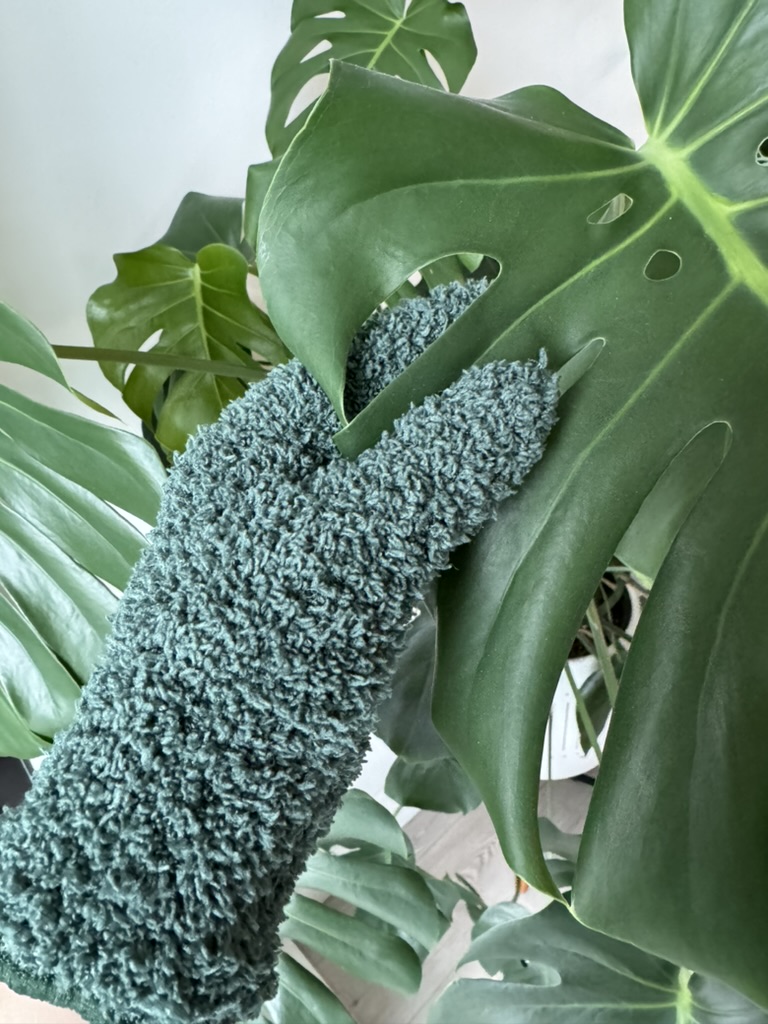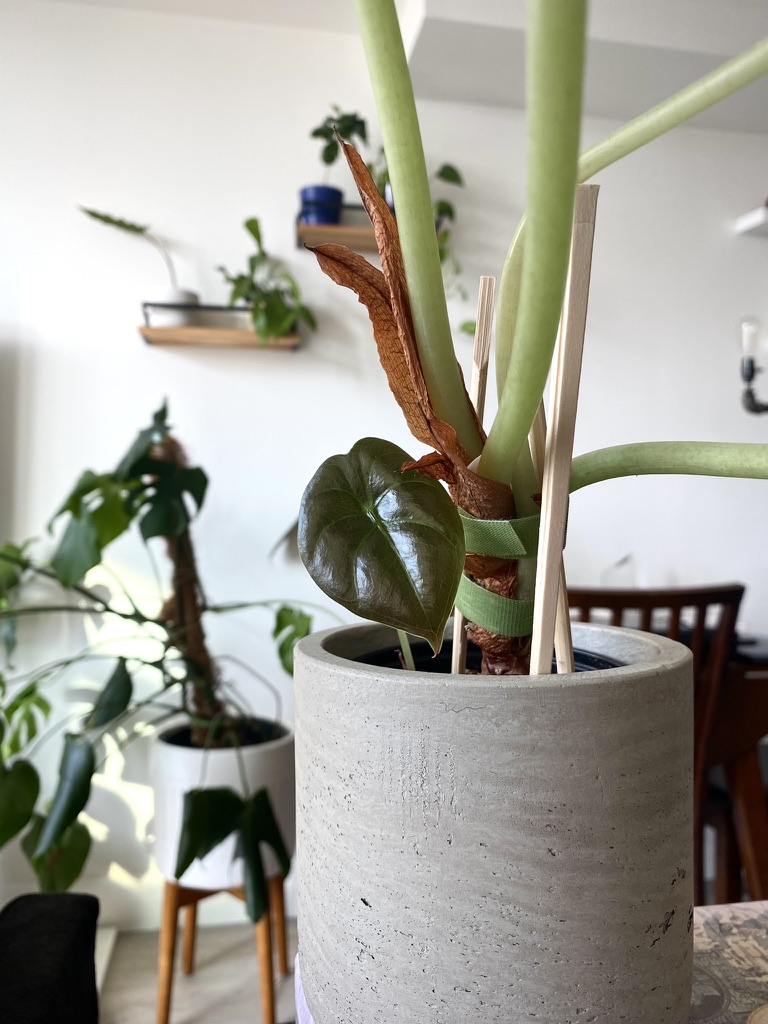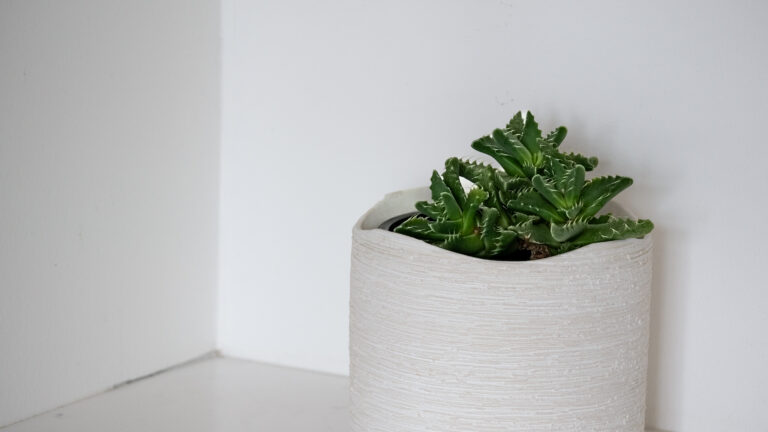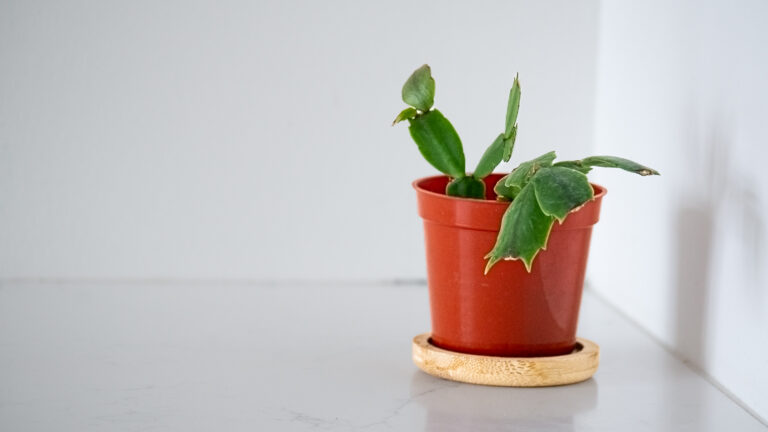Staghorn Fern or Platycerium bifurcatum is a member of the Polypodiaceae family. It is native to Pacific Regions like Australia and New Guinea.
There are around 1,650 species of the Polypodiaceae family with 18 of them being fern species within the Platycerium genus.
Platycerium bifurcatum is referred to as the Staghorn Fern because this fern’s fronds resemble the horns of a stag.
The plant care for the Staghorn Fern is a bit different than your usual plant care. Some things you would normally do (e.g. wipe down your plants leaves) can damage the fronds. More on this below!
🪴 Appearance of Staghorn Fern
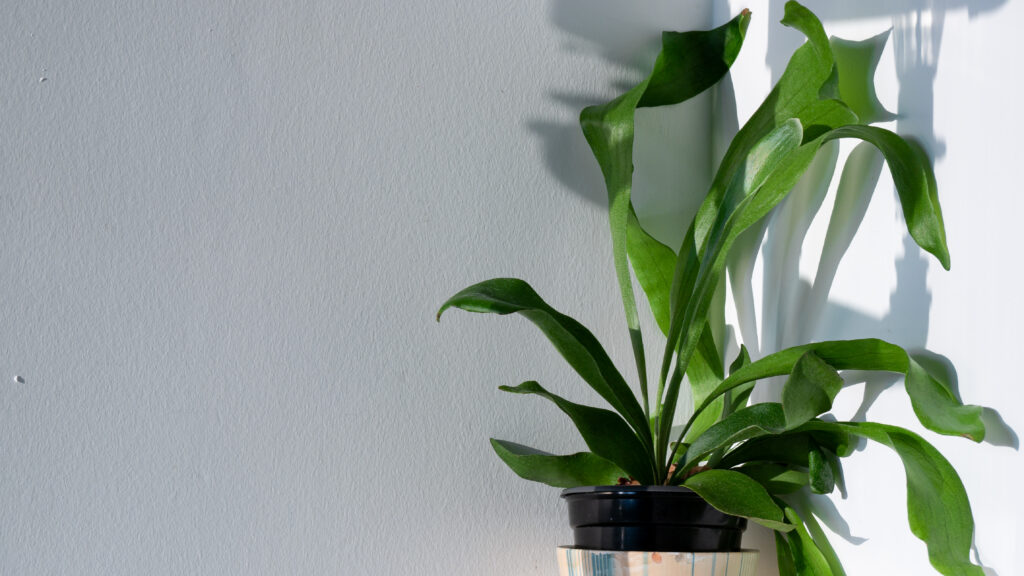
The Staghorn Fern has long, green fuzzy fronds that grow out from the round shield fronds in the middle of the plant.
As the plant matures, the fronds become bifurcated (forked) and resembles a deer’s antlers.
Older shield fronds turn brown and appear dried out (almost looks dead), but don’t remove these as it can damage the plant! New shield fronds grow on top of the old ones.
The Staghorn fern is epiphytic which means it usually grows on trees in its natural habitat. Many people will mount their Staghorn Fern to a piece of wood (myself included) to mimic this.
I learned how to mount my Staghorn Fern from Hilton Carter’s book Wild Creations.
☀️ What Light Does Staghorn Fern Need?
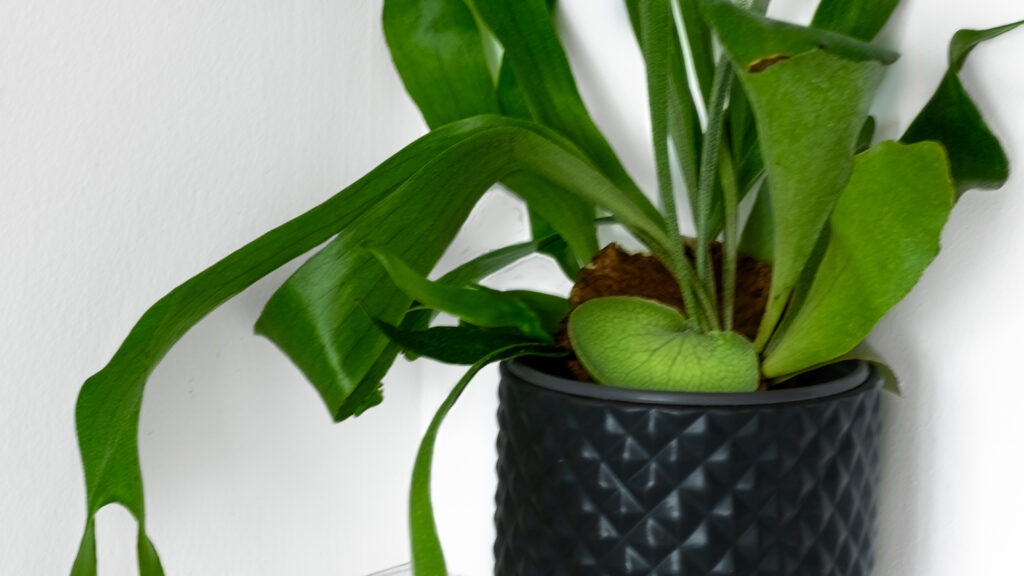
Staghorn Fern thrives in bright, indirect light. It shouldn’t see bright, direct light for the majority of the day, but some light in the early morning or evening will be okay.
I currently keep my Staghorn Fern on the wall near a north-west facing window. I previously had it in the middle of a south-west facing room and it liked this area as well.
🌡️ Temperature & Humidity 🌫️
Staghorn Fern prefers average household temperatures between 18-24 degrees celsius.
They also thrive in humidity levels of 60-80%. I keep mine in a room with higher humidity in my apartment, and close to my Levoit Humidifier.
Since I live in Canada and the winters can be very dry (below 30%) so a humidifier is essential. I keep my humidifier set to 45-50% all year to keep all of my plants happy and thriving. Also, its nice for humans to not have dry air as well.
🌱 How Does the Staghorn Fern Grow?
On average, Staghorn Fern can grow up to 3 feet.
The Staghorn Fern grows in really interesting ways. As an epiphytic species, it does best growing while mounted to a piece of wood, to mimic its natural habitat of growth on trees.
Platycerium bifurcatum has two types of fronds: shield fronds and bifurcated fronds. The Shield Fronds are at the base of the bifurcated fronds. Its bifurcated fronds emerge from the shield fronds. Don’t worry if your bifurcated fronds aren’t actually forked. This will happen as the plant matures.
As the shield fronds mature, they will turn brown and dry in appearance. Do not remove these. New, green shield fronds grow on top of the old fronds.
For a couple of years I kept my Staghorn Fern in its nursery pot, growing like a more traditional plant and it was very happy like this as well, but ever since I read Hilton Carter’s books, I knew I eventually wanted to mount my fern.
I learned how to mount my Staghorn Fern from Hilton Carter’s book Wild Creations.
🌸 Does the Staghorn Fern Bloom?
The Staghorn Fern does not bloom.
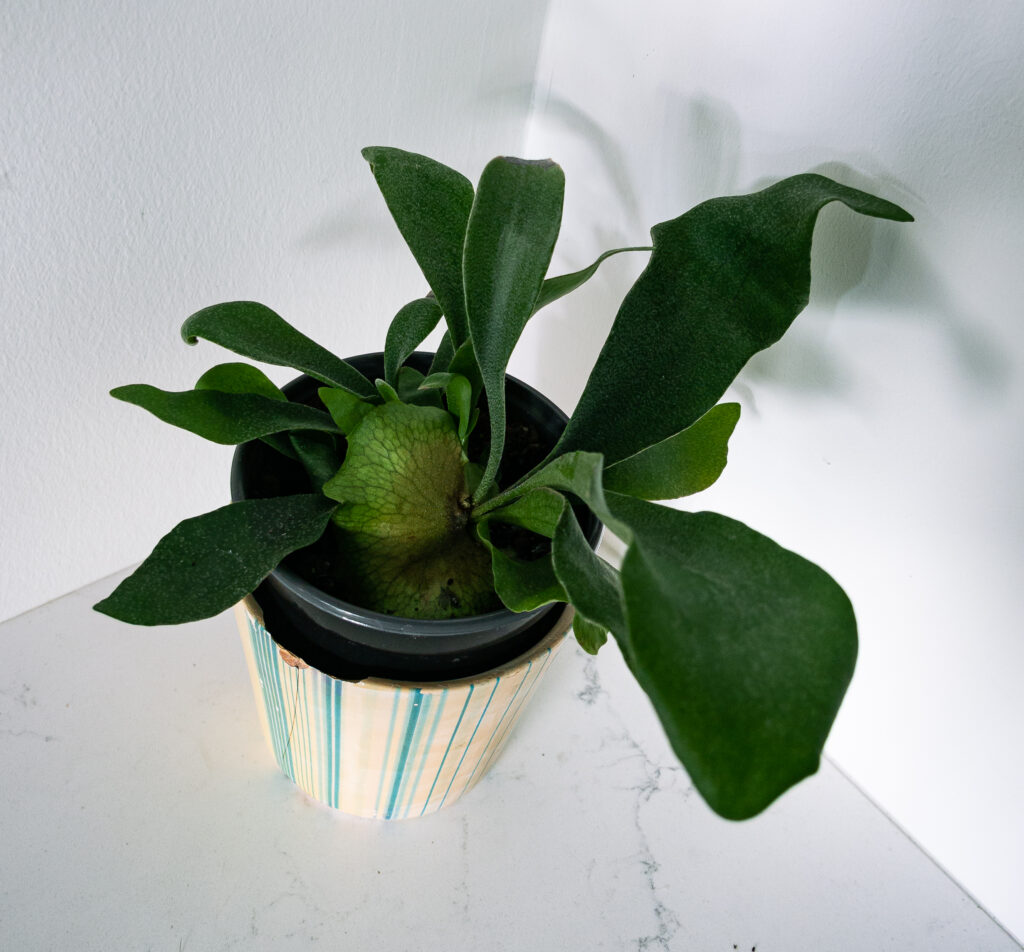
✂️ How to Propagate Staghorn Fern?
The easiest way to start a new Staghorn Fern is by removing offsets (pups) from the plant that will form at the base of the plant.
Make sure the pups are at least 2 to 3 inches tall, has fronds and roots before separating them from the mother plant. You will notice you have an offshoot when a new, smaller shield frond forms in your plant.
Gently remove the pups from the parent plant by separating them at the base with a knife (including the fronds and roots).
Pot the pups directly into well-draining soil that has a lot of coco coir or you can try to mount directly onto a piece of wood if you plan on mounting this to the wall anyways (follow the directions from Hilton Carter if you plan on wall mounting–I used coco coir instead of moss as this is an environmentally friendly alternative).
Water your staghorn fern after it has been securely potted or mounted. As Staghorn Ferns absorb water through their fronds, you can either mist the plant to water it or submerge it under water.
Remember, patience is key with propagation. Give your new plant time to settle into its environment. Once you see new growth, you know your plant is well established.
💧 How Much Water Does the Staghorn Fern Need?
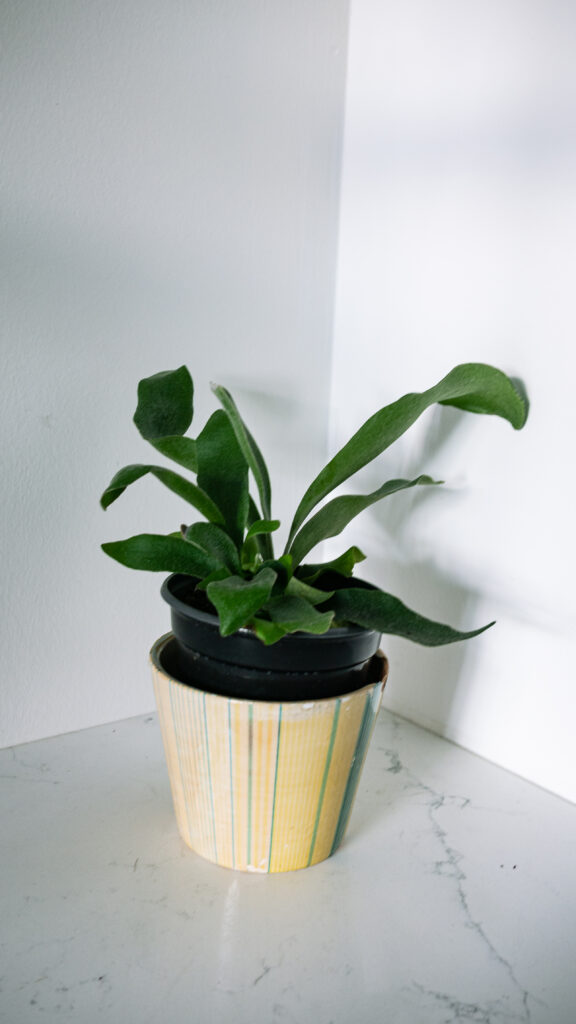
The Staghorn Fern likes to mostly dry out between waterings. This likely will take one to two weeks depending on your environment.
To determine if your plant needs water, you can stick your finger in the soil (1 to 2 inches) and if it is dry, its ready for water! If you don’t want to get your hands dirty, you can try a moisture meter or look at the fronds and notice if they are looking limper than usual.
When mounted, you might be also be able to look at the coco coir on the outside of the soil mound and determine this as well.
When my Staghorn Fern was in a nursing pot, I bottom watered it through the drainage hole of the pot on a tray. This way the plant can decide how much water it wants. Overwatering can lead to fungus gnats, root rot, or the death of your plant.
Since mounting my fern, I have watered it by submerging the fronds in water since this is where it absorbs the water anyways.
🪳 Pests & Problems 😔
Staghorn Fern can face the following pests and problems.
🪳 Pests
Few pests bother the Staghorn Fern, but they can become infected with scale and mealy bugs.
- Mealy Bugs: these look like little white cotton balls on the fern. You can remove these with your fingers if you catch them early enough, but I would use a cotton swab with a drop of Isopropyl alcohol and try to scrape them off the stem.
- Scale: Scale are small, brownish, round or oval insects that attach themselves to the leaves or stems of the plant. They are hard to notice as they appear like a growth or bump on the plant. Scale can cause yellowing, wilting, and weakened growth. Removing scale from a plant is tedious, like with mealybugs. You can remove scale by manually removing them with a cotton swab with isopropyl alcohol, using insecticidal soap or horticultural oil.
- Fungus gnats: Spray the plant with a mixture of neem oil, dish soap and water. I also let the soil dry out and add dryer sheets on top of the soil so the gnats can’t sense the moisture on the soil.
😔 Other Common Problems
Overwatering
Root rot happens from overwatering your plant with insufficient drainage or if you water your plant too frequently. Let your fern mostly dry out before watering. You can also end up with fungus gnats or fungal disease from overwatering.
Fronds Turning Black
This is a sign of overwatering. Cut back on the amount you are watering your fern.
Underwatering
Even though plants prefer to be underwatered over overwatered, you still have to remember to water it on a consistent schedule. Signs of underwatering an include wilting and/or discoloured fronds.
Wilting Frond Tips
This is a sign of underwatering. Water your plant more frequently, but be careful not to over water.
Drooping Fronds
Your plant is likely thirsty. Just give it a little water and it should be as good as new.
Yellowing Fronds
If you have a new frond coming in, your plant is likely fine. Plants pull energy from older fronds to support new growth. But it can also indicate over- or under- watering or lighting issues. Keep in mind, Staghorn Ferns don’t often have yellowing fronds. If this happens, I would pay closer attention to the plant to determine if there could be a larger problem.
White Fuzz Removed from Fronds
In typical plant care we wipe the leaves to remove dust. With the Staghorn Fern you do not want to do this. The white fuzz won’t grow back. This is something that helps the plant maintain moisture. To clean the plant you can mist it and shake the plant gently to remove any excess moisture.
Browning or Dry Shield Fronds
This is normal for the plant. Don’t remove the browning fronds.
Faded Fronds
This can be a sign of improper lighting or temperature issues. Sudden temperature changes can be shocking to plants. Keep temperature consistent and make sure your fern is receiving bright, indirect light.
Temperature Fluctuations
Plants prefers stable temperatures and are sensitive to cold drafts. Damage from cold temperatures can lead to vulnerability to disease, visible discolouration, growth stagnation or death. You can prevent this by making sure your plant is not exposed to environments below the recommended temperatures.
☢️ Are Staghorn Fern Toxic?
Staghorn Fern are typically not toxic to touch or consume, however some people may experience allergic reactions.
Staghorn Fern Quick Care Guide
| Scientific Name | Platycerium bifurcatum |
| Nickname | Staghorn Fern |
| Origins | Pacific Regions like Australia and New Guinea |
| Light | Bright, indirect light |
| Temperature | 18-24 degrees celsius (preferred) |
| Humidity | High (60-80%) |
| Height | Up to 3 feet |
| Blooms | No |
| Propagate | Offsets/Division |
| Water Frequency | When mostly dry (likely every two weeks) |
| Pests | Mealy Bugs, Scale |
| Common Problems | Overwatering (root rot, fronds turning black), underwatering (drooping fronds, wilting frond tips), yellowing fronds, browning shield fronds (not a problem really), faded fronds, inconsistent temperature |
| Toxicity | Non-toxic |
References
Below is a list of external sources I consulted while writing this post. This post is a mixture of my own experiences, and the external sources listed below:
Jomo Studio – Staghorn Fern
Wikipedia – Platycerium bifurcatum, Platycerium & Polypodiaceae
Gardenia – Platycerium bifurcatum
Lively Root – Staghorn Fern Care
Wisconsin Horticulture – Platycerium Bifurcatum
Gardening Know How – Staghorn Fern Problems & Cleaning Staghorn Ferns
The Spruce – Platycerium
Greg App – Staghorn Fern Problems

